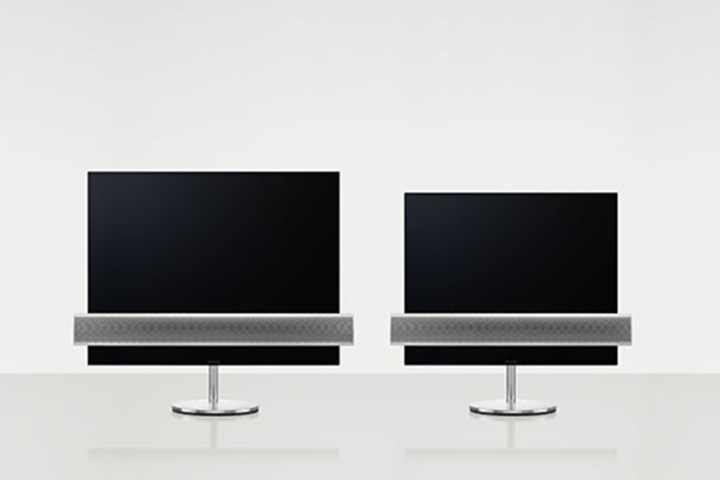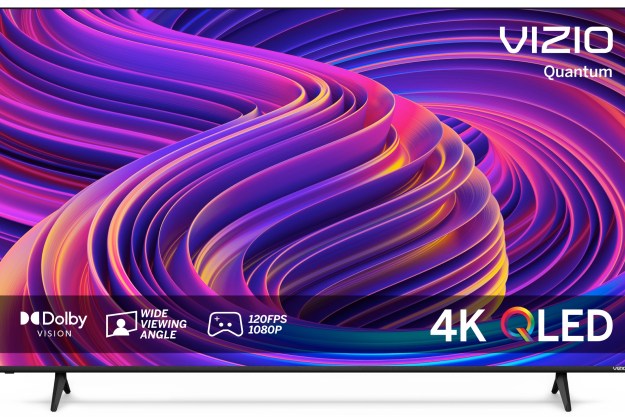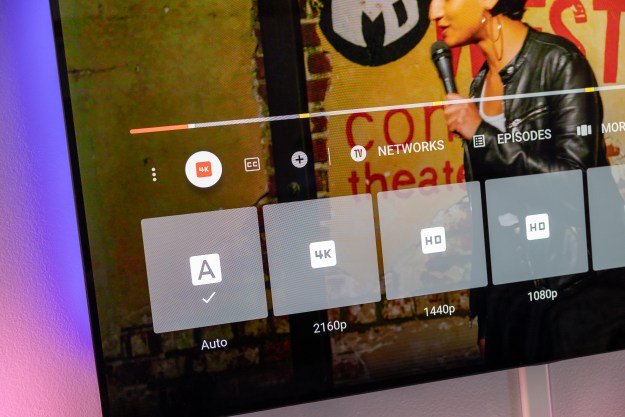The seeds of the partnership that Bang & Olufsen announced last year with LG have blossomed. The combination of LG’s OLED display tech and Bang & Olufsen’s impeccable audio engineering has brought to life a high-end 4K Ultra HD OLED TV, the BeoVision Eclipse, which launched during September’s IFA trade show in Berlin.
While this isn’t the first TV Bang & Olufsen has produced, it is the company’s first OLED model, and the BeoVision Eclipse ticks all the boxes you could want from an OLED TV, including 4K UHD resolution (of course), as well as Dolby Vision HDR support for better contrast and richer colors, all of which is further enhanced by the pure blacks and “near infinite contrast ratio” that OLEDs can achieve.
There are two sizes, 55-inch and 65-inch, and Bang & Olufsen has tuned the LG OLED panel to the company’s image quality standards. In our very brief demonstration, we were shown a clip from the sci-fi movie Passengers, which highlighted the screen’s amazing ability to produce inky blacks and startling splashes of color in complex scenes. The movie has a lot of CGI in it, which the BeoVision Eclipse didn’t obfuscate; but we suspect this is due to a overly eager-to-please blur reduction or similar mode on the demo set. This aside, the picture was brilliant, and packed with detail.
The BeoVision Eclipse’s really intriguing specs relate to the audio tech Bang & Olufsen has packed into it, in the form of a 450-watt, three-channel SoundCenter which can output sound in stereo or as a center channel. When used as a center channel in a multichannel setup, Bang and Olufsen claims the SoundCenter is capable of producing audio at the same level of quality as its BeoLab loudspeakers.
Hidden under the section beneath the screen, the Eclipse’s audio dominated our demonstration, having no problem filling the open and very noisy listening area where the TV was demoed. The Passengers movie clip was dialogue-free, but a selection of audio clips pushed the vocals out into the room with real authority, and even sitting off to the side, we never felt the need to move in closer to the a central sweet spot. This will make the television ideal for large rooms. However, the bass thump wasn’t as pronounced as we expected; but this is likely to be an issue with the listening environment more than the TV.
The BeoVision Eclipse runs on LG’s intuitive WebOS 3.5 Smart TV operating system which Bang & Olufsen has modified slightly for style and added in some custom options. It’s loaded with all the streaming apps you’ll need, including 4K apps like Netflix, and YouTube. Bluetooth, AirPlay, and a built-in Chromecast also enable you to stream or cast content directly from your phone. Spotify Connect is also onboard, all of which makes the BeoVision a proper entertainment center for the home.

The TV can be positioned on the floor using a stand, or on the wall via a floating wall mount. These are motorized. The wall mount angles the TV screen out by up to 90 degrees, allowing more flexibility on where the TV is placed in the room. The floor stand rotates, and can also bring the TV further out in the room by spinning the pole mount from the rear to the front of the base plate. Bang & Olufsen’s expertise with this kind of motorization really shows. The operation on both was smooth, considered, and at exactly the right speed. It’s also undeniably cool to see.
Not only have Bang & Olufsen and LG put some serious effort into A/V quality and accessibility, they’ve also gone to great lengths to make the BeoVision Eclipse look good. The SoundCenter, which can be customized with either an aluminum or fabric grille, extends beyond the sides of the screen. A strip of black glass also reaches below the bottom of the speaker, making for a unique TV design. The rear is completely uncluttered, with components hidden in a slim case on the lower half of the screen, leaving the ultra-thin top half alone. The BeoVision Eclipse also features its own universal remote, the BeoRemote One, which is long, slim and pleasantly weighty. It can also control other components connected to the TV.
If the BeoVision Eclipse sounds like a luxury product, that’s because it is — the 55-inch model costs the equivalent of a whopping $10,000, while the 65-inch model will go for around $15,000. Both models are slated for launch in September from select Bang & Olufsen retailers in Europe and the United Kingdom, and should be available to order now. Bang & Olufsen told Digital Trends a fall release is planned for the United States, but final prices haven’t been decided.
Update: We had a brief demonstration of the BeoVision Eclipse at IFA 2017, and have added in our impressions, along with more information.
Editors' Recommendations
- What we want to see from the next Apple TV 4K
- Samsung’s new 98-inch DU9000 4K TV is just $4,000. Can it beat TCL and Hisense?
- Hands-on with the Belkin iPhone Mount with MagSafe for Apple TV 4K
- If you don’t see CBS in 4K on YouTube TV, try this
- TCL’s giant 115-inch QM89 is the world’s largest 4K mini-LED TV


